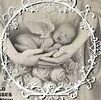From spit-ups to blowouts, newborn babies can go through multiple outfits in a day. Aim for a wardrobe of basics, like simple cotton bodysuits, that can be laundered regularly. Keep in mind that baby clothes are prone to shrinkage, so it may be smarter to shop for the size you think your baby will wear as opposed to what’s printed on the tag. It’s also a good idea to pick up extras, like hats and socks, that can be worn in colder weather.
You’ll need a supply of bodysuits, either short- or long-sleeved. These can be easily laundered and are a great foundation for layering in winter. You’ll also want a few pairs of footies (pants with built-in feet) to pair with onesie tops. Newborns have poor circulation in their feet, so it’s important to have thick mittens and socks on hand, too. Hats are crucial, too, because babies lose a lot of heat through their heads.
For nighttime, opt for a sleeper or a gown. The kimono-style ones that snap on the side are especially easy to get on and off. You’ll also want a few swaddles to help your baby feel secure and comfortable. It’s also nice to have a few special occasion outfits, such as one to wear home from the hospital and for photos or to meet family and friends.
A hoodie or jacket is also handy to have, especially for cold weather. You’ll want a few sweaters, too, to add over a onesie and tee or pair of footies. Be careful not to overbundle baby, though; they can become too hot and start sweating quickly. Signs of overheating include flushed cheeks and fussiness.
While it’s tempting to buy clothes in adorable prints, patterns and colors, remember that comfort should be your first priority. Fancy outfits can be itchy and scratchy, which will only make your baby uncomfortable. Stick to soft fabrics, such as organic cotton, and avoid textured or itchy materials like wool.
When shopping for baby clothing, consider how sustainable the production and manufacturing process is. Buying clothing made with environmentally-friendly practices reduces the industry’s ecological footprint and supports local communities.
It’s important to do your research when shopping for baby clothing, as different brands tend to run a little differently. Check out each brand’s specific sizing chart to determine where your child will fall within the range. Many parents also recommend picking up a few sizes up, as babies grow fast and it’s easier to move them into the next size before they outgrow an item than to deal with a tight fit. When in doubt, always visit a store in person to see how the pieces look in person. This will give you peace of mind that the items will actually fit your baby and prevent wasting money on items that won’t work.
